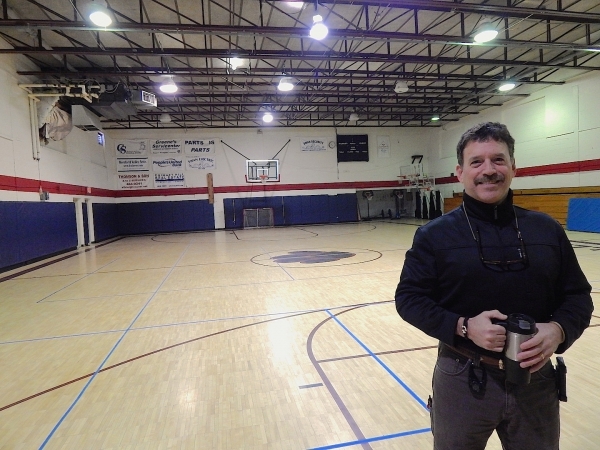WILMINGTON — As he walked the chilly, empty halls of this town's former high school on a recent morning, Steve Goldfarb talked more about the building's potential than its current condition.
If advocates can't find resources to repurpose the structure into a community center, “we could lose all of this,” said Goldfarb, chairman of the Old School Enrichment Council.
Goldfarb isn't alone in his enthusiasm: The community center project was named one of Windham County's 14 most “vital projects” on a list released Feb. 27 by Southeastern Vermont Economic Development Strategies.
It isn't yet clear when or how the center might come to fruition. But some say there is growing sentiment to transform a relic of recent school consolidation into an asset for the community.
“This project here - it's not just a priority. It's a necessity,” said Adam Grinold, Wilmington School Board chairman.
Grinold was speaking both as a school board member and as executive director of Brattleboro Development Credit Corp., the parent of Southeastern Vermont Economic Development Strategies.
Several years ago, those organizations developed a comprehensive economic development strategy, also called a CEDS, for the 27-town Windham Region. The document has several objectives including improving regional cooperation; creating an “entrepreneurial environment”; boosting wages; increasing the size and quality of the workforce; attracting younger people; and addressing the impacts of Vermont Yankee's closure.
Yearly ranking
Every year, the economic development organizations ask for a list of projects that could help meet those goals. An independent committee assesses those submissions and ranks them. The top selections are deemed the region's “vital” projects.
The Feb. 27 announcement of vital projects was held at the former Twin Valley High School to emphasize the fact that officials had added the community center initiative to the list.
The 52,000-square-foot building was vacated in 2014, three years after Wilmington and Whitingham residents voted to consolidate their elementary, middle, and high schools.
The building holds significance beyond its long history as a school: In 2011, it served as a temporary shelter when Tropical Storm Irene's severe flooding ravaged Wilmington.
“This was out of the flood plain, and this was the only place that people could easily get to for an emergency shelter,” said Meg Streeter, another member of the Old School Enrichment Council. “People lived here for almost two weeks.”
Goldfarb added that local residents and officials have been “trying to find a community center, a community kitchen, a community gathering place for Wilmington and the surrounding areas since the flood in 2011.”
So the availability of the school might seem fortuitous. And the building's abundant space has spurred talk of a variety of potential tenants including medical and municipal offices; fitness and adult daycare services; and even housing.
There is currently some community use of the structure, including the gymnasium. Those uses could increase if the building is sold and rehabilitated, Goldfarb said.
But there are many barriers for redevelopment advocates, and the building's future remains uncertain.
Two studies of the school's reuse - one for a “community and economic development center” and another that included relocation of town offices to the site - pondered renovation prices as high as $4.5 million.
Discouraging buyers?
Those costs may be keeping buyers at bay. The town voted last year to give Wilmington School Board authority to sell the structure, but a potential purchase bid dissolved.
Currently, Grinold said the Old School Enrichment Council “continues to pursue a purchase of the property. We have no other viable candidates at this time.”
Streeter said one proposal under consideration involves about $450,000 in renovations plus roughly $300,000 for demolition of the oldest portion of the school, thus making the space more manageable.
The council has raised a little money but hasn't yet launched a major fund-raising effort. “Our challenge,” Streeter said, “is how to pay for it.”
In the meantime, taxpayers continue to foot the bill to maintain the building. The sole tenant is Windham Southwest Supervisory Union's administrative office, but the entire structure must be heated to prevent sprinkler systems and pipes from freezing.
A study released last year said that, in fiscal year 2015, the building's operating expenses were approximately $136,000.
Those ongoing costs - coupled with the enthusiasm for the community center concept - might provide additional motivation to resolve the matter.
“I think our next step is to continue talking to the Wilmington School Board,” Streeter said. “We intend to finish the business plan that we did many components of with an architect's help a few years ago.”
The new “vital projects” listing doesn't come with any funding. But Streeter is hoping that, “by having an independent group say, 'What you're planning is important,' that kind of gives us a shot in the arm.”
In addition to the Wilmington Old School initiative, there were 13 other “vital projects” announced by Brattleboro Development Credit Corp.
Priority projects
Two of the projects are connected to a planned “Ecovation Hub” - an attempt to create a hub for environmentally friendly building and other “green” economic activity.
Several projects - including a Southern Vermont sustainable marketing plan; a workforce center of excellence; an “innovation ecosystem”; and infrastructure development at the Exit 1 Industrial Park - were submitted by the BDCC. Officials noted the BDCC isn't involved in the selection of vital projects.
Other projects on the list include:
• New England Center for Circus Arts' new school and performing-arts center, a project that's well under way in Brattleboro.
• Brattleboro-based Rich Earth Institute's attempt to “further develop capacity to produce urine-diversion systems for municipal use.”
• Efforts to revitalize the Retreat Farm in Brattleboro.
• Wilmington-based Wheel Pad L3C's development of environmentally friendly tiny houses for those with mobility problems.
• Brattleboro-based Strolling of the Heifers' Farm/Food Innovation Center.
• Efforts to “re-energize Vernon” via energy-related investments. Vernon officials have been discussing the town's energy future in the wake of Vermont Yankee's closure.
• The Six College Collaborative's workforce-training project in collaboration with area hospitals.
